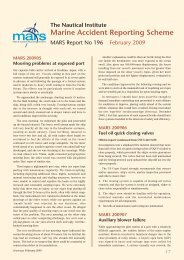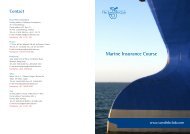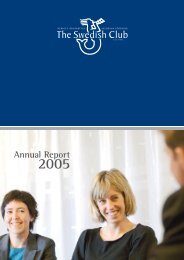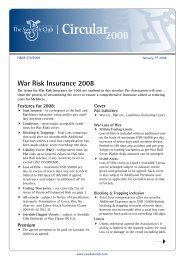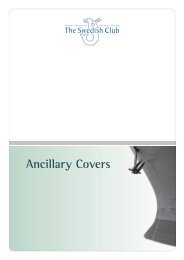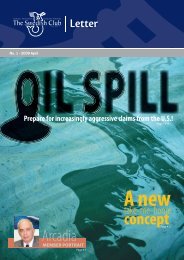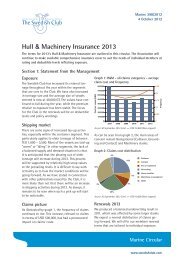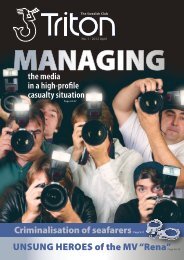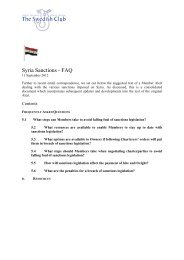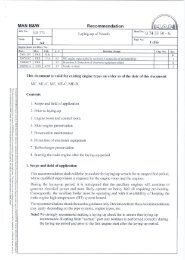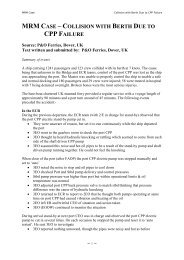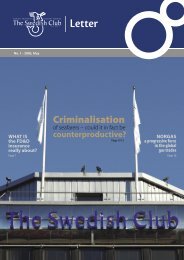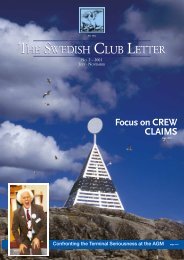SCL O4 - The Swedish Club
SCL O4 - The Swedish Club
SCL O4 - The Swedish Club
You also want an ePaper? Increase the reach of your titles
YUMPU automatically turns print PDFs into web optimized ePapers that Google loves.
Collision<br />
<strong>The</strong> <strong>Swedish</strong> <strong>Club</strong> Letter 3–2002<br />
Human error<br />
- a common cause in collisions10 6<br />
Tony Schröder<br />
CLAIMS EXECUTIVE<br />
Claims & Legal Support Department<br />
<strong>The</strong> <strong>Swedish</strong> <strong>Club</strong>, Göteborg<br />
Over the last years, <strong>The</strong> <strong>Swedish</strong> <strong>Club</strong><br />
has been involved in a number of collisions and<br />
the majority have occurred within port limits<br />
adjacent to pilot stations. <strong>The</strong> following article<br />
describes the circumstances of a collision which<br />
occurred three years ago in an area where it is<br />
compulsory to have a pilot and where proper<br />
shore radar surveillance is maintained (VTS 1 ).<br />
<strong>The</strong> intention of the writer is not to point a<br />
finger at who was to blame for the collision according<br />
to the rules of the road, but merely to<br />
illuminate and highlight the human factor by<br />
describing the events in a case where the prospects<br />
of avoiding a collision were favourable.<br />
<strong>The</strong> vessels were well sighted by each other<br />
at a sufficient time prior to the collision. <strong>The</strong>y<br />
had both reported to the VTS Wandelaar traffic<br />
control, which is compulsory, so the shore<br />
radar followed their targets. <strong>The</strong>re was also an<br />
agreement between the vessels that they should<br />
pass red to red, which is in accordance with the<br />
collision regulations.<br />
Both bridges were properly equipped and<br />
were manned with a master, pilot and a watchkeeping<br />
officer. Good weather conditions prevailed<br />
at the time.<br />
Preface<br />
On a clear night between November 8 th and<br />
9 th 1999, at approximately 0105 local time, our<br />
member’s container vessel, hereinafter referred<br />
to as the Alfa, collided with a smaller Ro-Ro<br />
vessel, hereinafter referred to as the Beta. <strong>The</strong><br />
Alfa was built in 1997 with a deadweight of<br />
49,210 tonnes, a length overall of 259 meters<br />
and a capacity to load up to almost 4,000<br />
TEUs 2 . <strong>The</strong> Beta had a deadweight of 3,548<br />
tonnes and a length overall of 95 meters.<br />
<strong>The</strong> maximum speed of the Alfa was approximately<br />
23 knots and the top speed of the<br />
Beta around 12 knots.<br />
<strong>The</strong> area where the collision occurred had,<br />
as mentioned, both radar and radio surveillance.<br />
Recorded evidence of this can be obtained<br />
from the authorities if need be. At the<br />
time of the collision, there were pilots on board<br />
both vessels.<br />
<strong>The</strong> Alfa had been in Zeebrugge discharging<br />
and loading. At 0030 local time, the cargo<br />
operation was finished and the pilot came on<br />
board to take the Alfa out. Six minutes later she<br />
had cast off with one tug assisting. <strong>The</strong> night<br />
was clear, with good visibility and a moderate<br />
NW wind of 3-4 Beaufort, more or less perfect<br />
conditions. At 0046 local time the tug was let<br />
go just inside of the port’s breakwaters.<br />
After the Alfa had let go of the tug, the<br />
pilot and the master had to struggle due to<br />
the circulating tidal current just inside the<br />
breakwaters in order to keep her aligned with<br />
the two leading lights out of Zeebrugge. After<br />
she passed the Zeebrugge breakwaters, at 0050<br />
local time, she put her engines to full ahead to<br />
avoid getting caught in the strong easterly set<br />
current outside the breakwaters.<br />
First sighting<br />
At the time the Alfa passed the breakwater,<br />
she was displaying three all-round red lights<br />
in a vertical line, showing she was a vessel constrained<br />
by her draught. Moments later, at 0051<br />
local time, the master and the pilot observed<br />
the Beta, and by the configuration of her navigational<br />
lights, they knew that she was coming<br />
from the west on an easterly course on the port<br />
side of the Alfa. <strong>The</strong> distance between the vessels<br />
at this point was 3.2 nautical miles. As the<br />
master of the Alfa immediately considered the<br />
heading and speed of both vessels as a possible<br />
close quarter situation, he asked the pilot to<br />
contact the Beta over the VHF.<br />
<strong>The</strong> Beta was proceeding from port Oran<br />
in Algeria. At 2310 local time she had picked<br />
up the pilot at Wandelaar pilot station and was<br />
now sailing in the inland traffic zone bound<br />
for Antwerp. Just before they passed buoy A2<br />
(see chart) they saw the Alfa outbound at the<br />
entrance to Zeebrugge. <strong>The</strong> oversized vessel<br />
navigational lights were duly recognised by the<br />
master, the pilot and the officers on watch on<br />
board the Beta. <strong>The</strong> pilot kept the EBL 3 of the<br />
radar on the target of the Alfa. According to the<br />
pilot, the bearing increased enough for him to<br />
feel comfortable that the Beta could pass ahead<br />
of the Alfa.<br />
Intentions<br />
After a couple of minutes, at 0055 local time,<br />
the Alfa called up the Beta on the VHF, asking<br />
for her intentions. <strong>The</strong> pilot on board the Beta<br />
then said, according to the VHF transcripts,<br />
that he would alter his course to starboard, in<br />
order for them to meet red to red, which is the<br />
proper way to meet according to the rules of<br />
the road. <strong>The</strong> pilot then, in his own mind, still<br />
RW<br />
A2<br />
11 4<br />
G 10 5<br />
9 2<br />
11 2<br />
saw it as possible for the Beta to pass ahead<br />
of the Alfa. <strong>The</strong> pilot of the Beta obviously<br />
waited, and hoped he could pass ahead of the<br />
Alfa in spite of the agreement over the VHF.<br />
This intention of the Beta was not advised to<br />
the Alfa.<br />
After a short time, while the speed of the<br />
Alfa was still building up, both the captain<br />
and the pilot of the Alfa started to get nervous.<br />
<strong>The</strong> bearing to the Beta was still unchanged.<br />
<strong>The</strong> Alfa interpreted the situation as though<br />
the two vessels would collide if no action were<br />
taken. <strong>The</strong> master of the Alfa told the pilot to<br />
call the Beta on the VHF yet again and ask for<br />
her intentions, which he did.<br />
<strong>The</strong> master of the Alfa did not understand<br />
what was said over the VHF because both pilots<br />
were speaking the local language, which was<br />
Flemish. <strong>The</strong> pilot of the Alfa informed the<br />
master that the Beta would alter her course<br />
to starboard and that they would meet red<br />
to red and pass astern of the Alfa. During<br />
the following relatively short time (about 3-4<br />
minutes), the master and the pilot of the Alfa<br />
saw no change in the course of the Beta. As<br />
nothing happened, the pilot and the master<br />
8<br />
1<br />
Vessel Traffic Service<br />
2<br />
Twenty Foot Equivalent Unit – Unit of measurement equivalent to one standard twenty foot container



